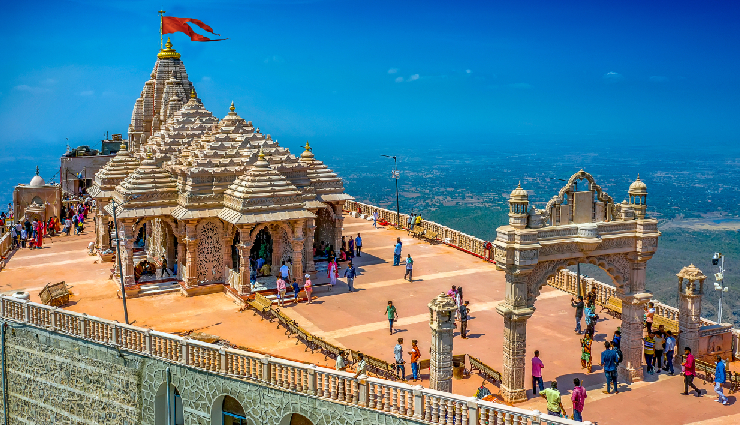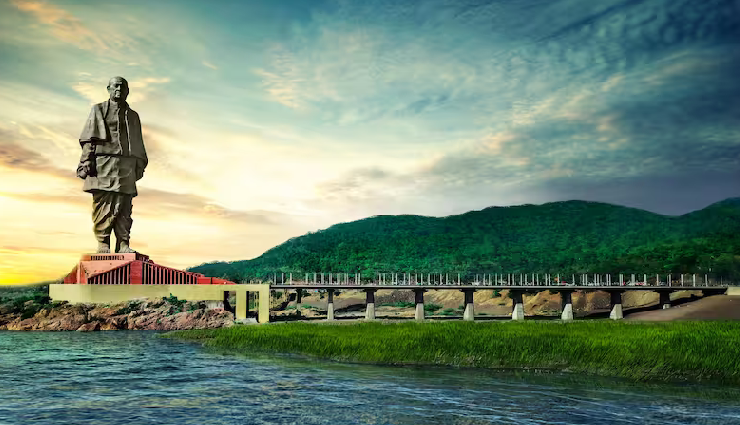
In Gujarat, you'll discover numerous places where you can engage with welcoming locals and savor delightful cuisine. The state beckons for various reasons, whether it be witnessing dinosaur fossils or experiencing the exclusive habitat of Asiatic Lions. Gujarat offers a diverse range of experiences, from the awe-inspiring beauty of the Somnath Temple and Jain Architecture to the enchanting Dwarka emerging along the Arabian coast. With an array of renowned destinations to choose from, Gujarat promises a memorable and fulfilling travel experience.

This destination is a top choice for families and tourists in Gujarat. Known as the world's tallest statue, the Statue of Unity pays tribute to Sardar Vallabh Bhai Patel, India's inaugural deputy prime minister and home minister. Soaring at an estimated height of 597 feet, it surpasses the Statue of Liberty in the United States by twice its stature.
Visitors have the opportunity to explore and appreciate the 135-meter-tall gallery, with a maximum capacity of 200 people per entry. While there, don't miss the chance to take in the awe-inspiring vistas of the Vindhyachal and Satpuda mountains, as well as the stunning panorama from the dam. The construction of the statue spanned approximately four years, utilizing iron gathered from various regions across India. It stands as one of the most exquisite attractions in Gujarat.
Junagadh, which translates to old palace, is a city deeply embedded in historical narratives. It is a place adorned with Buddhist and Hindu temples, as well as glistening mosques that once echoed with the prayers of Muslims. The remnants of the Babi Nawabs' reign, extending until India gained independence, can be witnessed through various monuments. Beyond its historical significance, Junagadh is renowned for its vibrant culture, marked by music, dance, spices, pickles, and the warm smiles of its residents.
Despite being often overlooked by tourists, this location should not be dismissed, as it holds a wealth of historical monuments. Maqbara Mahabat stands as a testament to opulent and skillful architectural design, while the Ashokan Rock Edict is another noteworthy feature awaiting exploration.
Besides being the country's fifth-largest city, Ahmedabad is hailed as the premier destination in Gujarat, celebrated for its rich cultural heritage, exquisite monuments, and resilient inhabitants. Established in the 11th century by King Karnadev, the city underwent a transformation when Sultan Ahmed Shah overthrew the king, renaming the city after himself from its original moniker, Karnawati.
A visit to Bhadra Fort reveals some of Ahmedabad's finest historical monuments, mosques, buildings, and lakes. Sabarmati Ashram, a popular spot for both families and tourists, offers a glimpse into the historical wonders of Bhadra Fort, including Jhoolta Minaar and the iconic teen Darwaza. The scenic Kankaria Lake, adorned with emerald beauty, provides a serene setting.
The festive season, particularly during Navratri and Uttarayan, is the ideal time to experience Gujarat's vibrant culture, marked by fervent celebrations. Witness the enthralling kite-flying competition, where participants from around the globe showcase their impressive skills. Ahmedabad also stands out for its delectable cuisine, adding another enticing dimension to the city's allure.
Baroda stands out as one of Gujarat's most sought-after tourist destinations, holding the esteemed title of the state's cultural capital and drawing visitors from across the globe. After the Marathas ousted the Mughals, Baroda became the capital under the leadership of Maratha generals.
This city offers a blend of historical culture and contemporary architecture. During the rule of Maharaja Sayajirao II, Baroda flourished and progressed, enjoying a degree of autonomy even under British rule.
Baroda boasts several renowned attractions in Gujarat. Among them, Lakshmi Vilas Palace, Kadia Dungar, Makarpura Palace, Sayaji Baug, and Nazarbaugh Palace stand out as remarkable sites. Sayaji Baug, named in honor of Maharaja Sayajirao, was established in 1879 and was also known as Kamati Baug. The expansive grounds house two museums, a flower clock, a toy train, an animal sanctuary, and a planetarium, contributing to the city's allure.
Your fondness for animals aligns perfectly with the only national park in Asia where the majestic jungle king roams freely. Nestled in the Junagadh District, this spot ranks among the top and most enjoyable activities in Gujarat. The primary attraction is the presence of lions, a unique feature not found elsewhere, with the added conservation of various other animal species in the area.
The park is home to a diverse range of wildlife, including leopards, antelopes, hyenas, marsh crocodiles, numerous bird species, and sambar. While many visitors come to witness the Jungle King, Gir is also a haven for bird watchers, offering some of the finest bird watching experiences in India.
For those planning a visit, the winter months, particularly November, provide an ideal climate. However, if the goal is to catch a glimpse of a lion in action, the hotter seasons, such as April, are recommended.
Renowned for its extraordinary religious monuments and ancient ruins tracing back to the 8th century, this site is a must-visit for history enthusiasts and individuals keen on exploring diverse historical architectures and cultures. Evolving over 600 years, the area encompasses agricultural, religious, and military structures. It fell into abandonment when it ceased to be Gujarat’s capital, a status it held only briefly under Sultan Mehmud Begda’s rule.
Constructed during Begda’s reign, the Jama Masjid stands as an exemplar of pinnacle Indo-Islamic architecture. Subsequently, it became a venue for Friday prayers.
Would you like to immerse yourself in the expression of a queen's love for her king? This distinctive monument ranks among the finest places to explore in Gujarat, standing as the best-preserved stepwell to date. Erected by Rani Udayamati in heartfelt tribute to her late husband, King Bhimdev the First, this structure holds a unique significance.
Upon its completion, the location faced inundation by silt and water from the nearby Saraswati River. Only in 1980 did the Archaeological Survey of India (ASI) excavate the Vav, revealing the submerged structure. The excavation brought to light the exceptional craftsmanship of niches, intricately carved sculptures, and compartment pavilions. This site stands as one of the largest and most impressive step wells, showcasing a magnificent architectural legacy.
Descending the steps leads to pavilion-marked stepped corridors, featuring sculptures primarily centered around the Desavataras, also known as the ten incarnations of Vishnu. These sculptures depict apsaras, sadhus, and brahmins as the incarnations.
Situated in Gomti Creek, this temple stands as one of the nation's most exquisite and sophisticated, believed to be constructed by the grandson of Hindu God Krishna. The temple seemingly emerges from the Arabian Sea, renowned for its intricately carved architecture and holds a significant place as the most sacred temple in Hindu scriptures.
In Hindu mythology, the lore narrates that God Krishna used to journey to Dwarka with the Yadava Clan. Dwarka, submerged in the waters after Krishna's demise, is now a subject of recent reports, indicating it as one of the six ancient cities that once thrived.
This stands as one of Shiva's holiest Jyotirlingas, with Hindu mythology recounting that the Moon God, Soma, constructed the temple using gold to pay homage to their deity and his benevolence. Subsequently, the temple earned the name Somnath temple. According to legend, Somnath Mandir underwent reconstruction by Ravana in silver, King Bhimdev in stone, and Krishna in wood.
Situated on the shores of the Arabian Sea, the Somnath Mandir has witnessed multiple reconstructions due to destruction on various occasions. Annually, a multitude of Hindus and pilgrims converge here to seek the divine blessings of their revered deity.
Bhuj, located in Gujarat, stands out as a premier destination for friends and family seeking an immersive experience in rich culture. The city boasts a blend of British and modern Indian architecture, woven into the tapestry of various civilizations, ranging from the Mahabharata and the era of Alexander the Great to the Indus Valley period. Beyond its appeal as a tourist destination, Bhuj is a treasure trove of traditional handmade crafts, textiles, jewelry, and cultural artifacts.